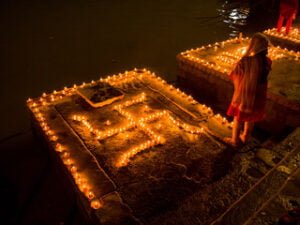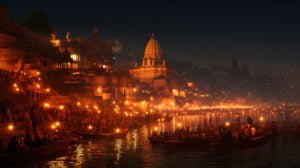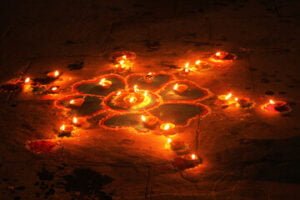No products in the cart.
VARANASI
Uttar Pradesh
An Illuminating Dev Diwali
From the banks of the holy Ganga, the boats appear to be floating on a veil of fog. The first rays of the morning burn away the night mists to reveal one of the most evocative scenes enacted down the centuries at dawn each day in the holy city of Varanasi in Uttar Pradesh.  Hundreds of devotees stand knee-deep in the sacred waters paying obeisance to the rising sun in this “City of Light’, the earthly abode of Lord Shiva who first pierced the primordial darkness of Earth with his celestial light.
Hundreds of devotees stand knee-deep in the sacred waters paying obeisance to the rising sun in this “City of Light’, the earthly abode of Lord Shiva who first pierced the primordial darkness of Earth with his celestial light.
The Holy Ganga, the hallowed ghats (there are 84 of them spread over a stretch of about 7 km, curving along the crescent-shaped bank) and the ancient temples, play a pivotal role in Varanasi’s cultural moorings. Visitors down the decades have been drawn like lemmings during its festival season to imbibe this fabulous legacy of worship and cultural richness.  The city has long been hailed for its stunning celebration of Diwali, the Festival of Lights, but not everyone is aware that Varanasi celebrates Diwali twice. Diwali and Dev Diwali. Both Diwalis hold great spiritual significance for Shaivite, Vaishnavite, Jain and Sikh devotees.
The city has long been hailed for its stunning celebration of Diwali, the Festival of Lights, but not everyone is aware that Varanasi celebrates Diwali twice. Diwali and Dev Diwali. Both Diwalis hold great spiritual significance for Shaivite, Vaishnavite, Jain and Sikh devotees.
Diwali as we know it is a pan-India festival celebrated on Amavasya or the moonless night. The festivities celebrate the triumphant return of Lord Rama to Ayodhya after 14 years of exile and his victory over Ravana, the demon king of Lanka.
Dev Diwali or the Diwali of the Gods is celebrated only in Varanasi. It takes place on a full moon night on Kartik Purnima,15 days after Diwali. Dev Deepawali celebrations begin on the Ekadashi tithi of Kartik Shukla Paksha and end on the fifth day, which is the Kartik Purnima tithi (full moon night) according to the Hindu calendar.
This grand festival is a celebration of the gods who descend on earth from the heavens to bathe in the holy waters of the Ganga to a tumultuous welcome from their devotees.
Dev Diwali is truly an auspicious day. In Shaivite traditions, Dev Deepawali also marks the day Lord Shiva defeated three demons—Vidyunmali, Tarakaksha, and Viryavana, together known as Tripurasura. The day is also known as Tripuri Purnima. Dev Diwali is also the birth anniversary of Lord Kartikeya, the God of War, who is Lord Shiva’s son. It’s also the day Lord Vishnu transformed into his first avatar as Matsaya or a fish. This auspicious day holds great significance for significance for the Vaishnava devotees.  It also celebrates the marriage of the sacred Tulsi plant with the Shaligram, a symbol of Lord Vishnu. In Hindu homes, all across Gujarat devotees honour the day by organizing rituals that involve all the ceremonials of a wedding performed between the Tulsi and the Salagram. The Sikh community also celebrates Gurupurab or Prakash Parva, the birthday of Guru Nanak, on Kartik Purnima. Jain tradition has ,it that Lord Mahavira attained realisation during Diwali; it was during Dev Diwali that he achieved liberation.
It also celebrates the marriage of the sacred Tulsi plant with the Shaligram, a symbol of Lord Vishnu. In Hindu homes, all across Gujarat devotees honour the day by organizing rituals that involve all the ceremonials of a wedding performed between the Tulsi and the Salagram. The Sikh community also celebrates Gurupurab or Prakash Parva, the birthday of Guru Nanak, on Kartik Purnima. Jain tradition has ,it that Lord Mahavira attained realisation during Diwali; it was during Dev Diwali that he achieved liberation.
The explosion of festivities is marked by the lighting of millions of earthen lamps on the ghats. Residents light up their homes to create a fairyland ambience. Colourful rangolis are described at home entrances on this auspicious occasion when all the deities are welcomed to the holy city.
Varanasi becomes a riot of colour and pageantry as devotees throng to pay homage to the deities carried out in several processions along designated routes. The tradition of lighting hundreds of earthen lamps along the Panchganga Ghat down to the water’s edge on this auspicious day started way back in 1985. Today one of the main highlights of the festivities is the millions of earthen diyas lighting the way of the gods to the sacred river from Raj Ghat to the Ravidas Ghat on Dev Diwali.  These illuminations are also a form of propitiating the holy Ganga. Lakhs of lamps illuminate the city’s ghats, ponds, and lakes. The Srikasi Vishwanath Temple, along with other significant shrines in the city, is richly decorated with floral arrangements and lit up for the occasion.
These illuminations are also a form of propitiating the holy Ganga. Lakhs of lamps illuminate the city’s ghats, ponds, and lakes. The Srikasi Vishwanath Temple, along with other significant shrines in the city, is richly decorated with floral arrangements and lit up for the occasion.
Devotees gather in huge throngs to perform the ritual purification dip (Kartik snan) in the Ganga at dawn. At dusk, they perform the ritual Deepdan by offering beautifully lit diyas to the Ganga. An unmissable part of all this spiritual energy is the elaborate Ganga Maha Aarti performed by 21 Brahmin pandits at Dasaswamedh Ghat. Pilgrims and visitors also throng the other ghats where an aarti is also organized on a grand scale for the occasion. Devotees thrill to the sound of drum beats, blowing of conch shells, reciting of traditional mantras and chanting of hymns. Local boatmen wait for custom on beautifully decorated bajadas to cruise the river waters past the grand spectacle of the beautifully illuminated city. Folk artists are also roped in to present
cultural programmes.
The day also is marked by a ceremonial event on the ghats in memory of those of India’s armed forces who were martyred while fighting for India.
















